Specific measurements:
Overall length: 60 1/2"
Barrel length: 45 1/2", smoothbore
Barrel: octagon to round, 1" across flats at breech, 13/16" diameter at
muzzle
Trigger pull: 13"
Drop at heel: 3 3/4"
Drop at toe: 8"
Wrist height: 1 3/8"
Wrist width: 1 3/8"
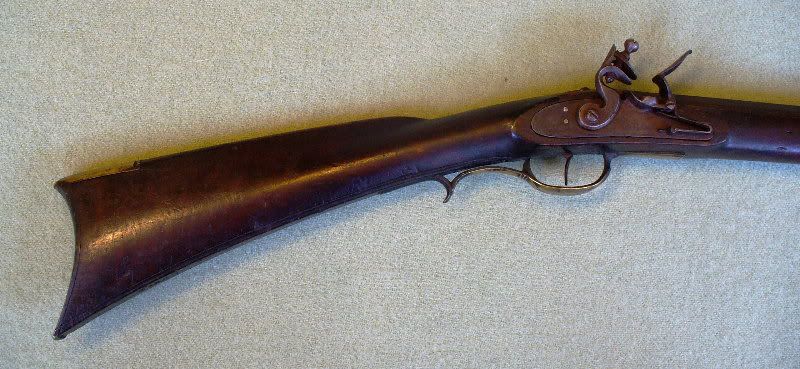

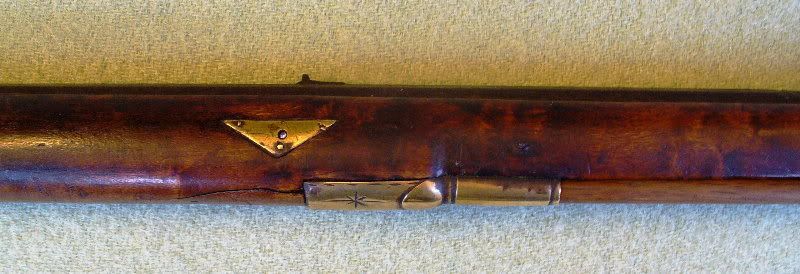
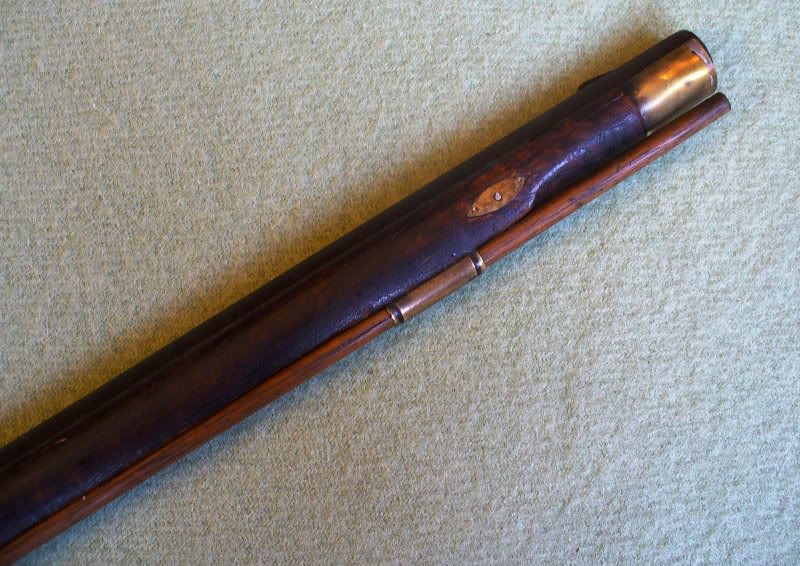

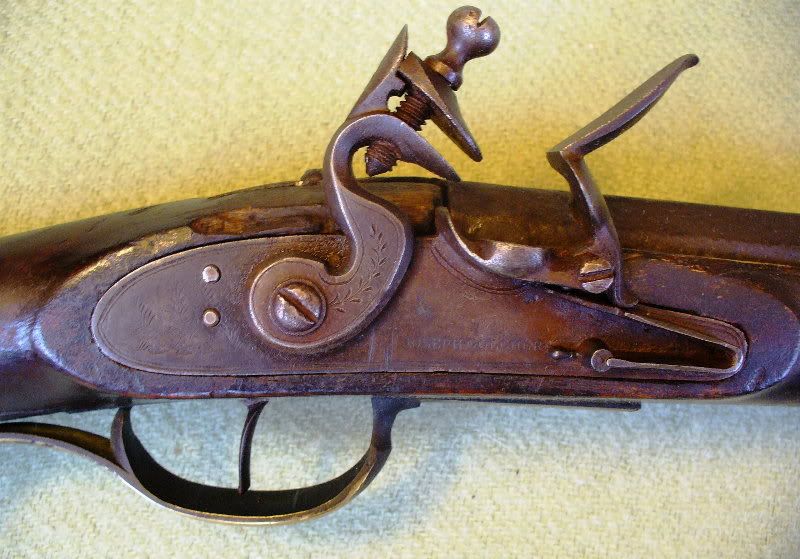

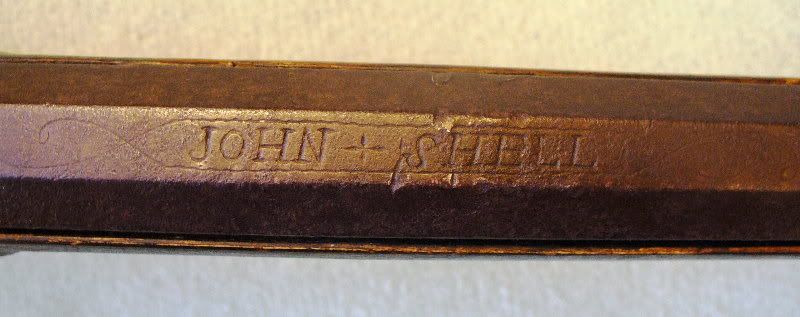
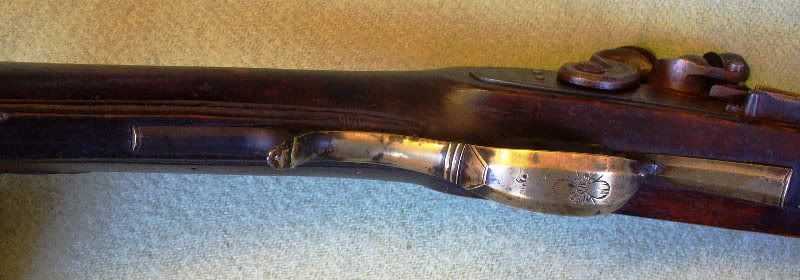
Comments:
An interesting Shell smooth rifle in fiintlock. The barrel is long for his usual pieces and the number 80 on the side plate suggests that this is one of his earlier products, if he numbered his guns in order. It is in attic condition and still in flint. For what may have been a relatively low cost piece, it stil has some nice little refinements of engraving, inlays, and a nicely made trigger guard.
=====================================================
A nice PA working rifle by a known maker in pleasing condition.
=====================================================
Yes, a nice honest rifle in just the condition one would hope to find it in.
=====================================================
This is a representative example of this Pennsylvania John Shell's work. However, I think it was probably an original percussion gun, based on a several of details. Note the pointed, extended toe that suggests the percussion era. In addition, the lock appears to be an original percussion plate that was improperly converted to flint, with an oversized cock. The cut in the stock behind the cock appears new, rough and unworn. Note the double line engraved border on the Joseph Goulcher lock; it runs completely around the outer edge of the plate, particularly in the area where the frizzen spring is attached. Goulcher locks, if originally flint, generally have the border engraving stop ahead of the frizzen spring attachment screw, then resume after it. The pan also sits at a slight angle to the barrel center line. This is a decent rifle for the museum, with the proviso that the gun was probably made in the percussion era, and has been made into a flintlock in more recent times.
=====================================================
A very astute observation. I don't disagree. Fifty years ago, there were an awful lot of percussion guns "re-converted" that were never flint in the first place. This one certainly has all of the earmarks.
=====================================================
On the other hand folks. we have a two bolt lock and the serial number of 80 on the side plate. To me, this means that it is a fairly early gun in the series. The lock plate is round ended, but this style became common around 1820. The plate looks like it is intact and has not been altered if we consider that the molding lines appear to be correct.
As it happens, I have a Shell smooth gun much like this one, that has a single bolt plate, is original flint, a Belgian barrel, a borrowed butt plate, and no serial number. The gun is correct as far as I can determine. When guns began to be converted back to flint and from original percussion to flint, erroneously, there seemed to have been little concern as to what parts went into the process. I have seen KY Rifles with French locks in them, done back then. The master restorer, Keith Neubauer was one of the first to notice that certain locks possessed specialized part; e.g. Germanic locks had quartered pans, heavy hammers etc., and that English locks had their own shapes and styles. He very quickly made sure to add the correct parts when he did reconversions.
Part of solving the problem, I guess involves knowing what year #80 was made. Anyone out there have this on hand? Sometimes we see too much in what we look at.
=====================================================
Working with Bill LePard, the Shell relative, we have identified 5 other John Shell guns in public places. He intends to visit them this summer and photograph them. Perhaps then we will have several in sequence to follow this masters work over time. If anyone knows of a Shell, I would appreciate it if we could get pictures. It could be an amazing exhibit and a quite a study.
=====================================================
As we look at this gun's lock, I think there is a visible repair/plug in the barrel wall behind the pan area, seen as a circle of lighter colored metal, where a percussion gun with side lug had the barrel closed/welded in preparation for changing it back to a flintlock. That alone, I think, indicates the plate (which appears original to the gun) has been altered.
All parts of an original and unaltered flintlock generally flow together well and don't raise red flags. This one has several red flags with its current configuration. If there is disagreement with the prior statement that these late style round tail locks with flat faces, when flint, have the border engraving stop on either side of the frizzen spring screw, I'd sure like to see an original flint where the border runs on through that area. I've seen a good number of such locks, and don't recall ever seeing a Goulcher made/engraved that way. The gun's stock, with pronounced pointed toe and rather large area of side facing around the nose of the lock plate, tends to point toward a percussion era gun as well. And how do we explain what appears to be a "new" cut in the stock wood above the lock plate??? If that Goulcher plate were originally a flint, I would think the odds are in favor of it having a double throated "military" type cock, not this big goose neck style with an earlier style engraving.
Of course, we cannot say positively that the gun was not a flintlock originally, but there are indications this gun was percussion at one time re: the plug behind the pan, with the current lock plate. So then we have to look at other details on the gun, specifically its stock architecture, butt height/thickness/drop, furniture style, thickness, caliber, etc. compared to other PA guns, to form a "most probable" conclusion. It seems we never have complete enough information on these posted guns. But from what I can see, it appears that: a) the gun was in fact percussion at one time, b) it probably has its original lock plate, and c)the current lock configuration raises some red flags. Any chance we can get a butt width measurement and caliber?

